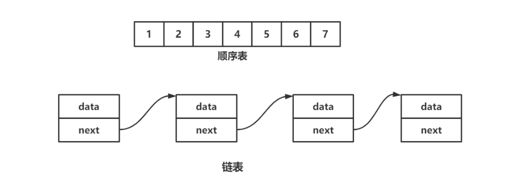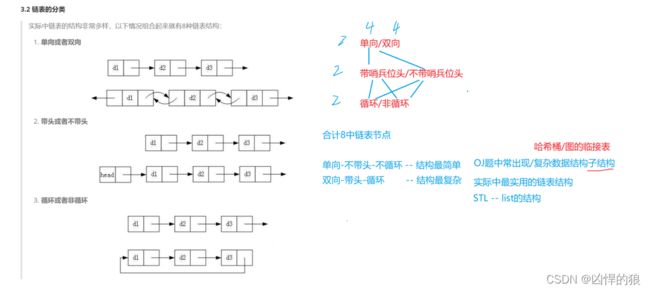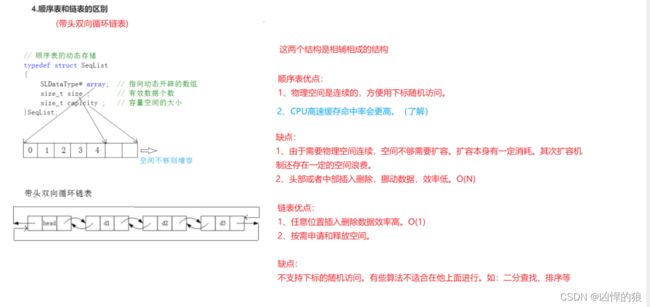数据结构:链表和顺序表的实现
线性表
线性表(linear list)是n个具有相同特性的数据元素的有限序列。 线性表是一种在实际中广泛使用的数据结 构,常见的线性表:顺序表、链表、栈、队列、字符串… 线性表在逻辑上是线性结构,也就说是连续的一条直线。但是在物理结构上并不一定是连续的,线性表在物 理上存储时,通常以数组和链式结构的形式存储。
文章目录
-
- 顺序表
-
- 静态顺序表(使用定长数组存储数组元素)
- 动态顺序表(使用动态开辟存储数组元素)
-
-
- 头文件
- 源文件
-
- 链表
-
- 无头单向非循环链表
-
-
- 头文件
- 源代码
-
- 带头双向循环链表
-
-
- 头文件
- 源代码
-
- 总结
- 链表和顺序表的对比
顺序表
顺序表是用一段物理地址连续的存储单元依次存储数据元素的线性结构,一般情况下采用数组存储.在数组 上完成数据的增删查改.顺序表一般可以分为:静态顺序表和动态顺序表
静态顺序表(使用定长数组存储数组元素)
动态顺序表(使用动态开辟存储数组元素)
头文件
// SeqList.h
#pragma once
#include 源文件
// SeqList.c
#include "SeqList.h"
void SeqListInit(SeqList* ps)
{
assert(ps);
ps->a = NULL;
ps->size = 0;
ps->capacity = 0;
}
void SeqListDestory(SeqList* ps)
{
assert(ps);
free(ps->a);
ps->a = NULL;
ps->size = ps->capacity = 0;
}
void SeqListPrint(SeqList* ps)
{
assert(ps);
for (size_t i = 0; i < ps->size; ++i)
{
printf("%d ", ps->a[i]);
}
printf("%\n");
}
void CheckCacpity(SeqList* ps)
{
if (ps->size == ps->capacity)
{
size_t newcapacity = ps->capacity == 0 ? 4 : ps->capacity * 2;
ps->a = (SLDateType*)realloc(ps->a, newcapacity*sizeof(SLDateType));
ps->capacity = newcapacity;
}
}
// 以下几个接口先讲不复用Insert和Erase的实现,最后再讲复用实现
void SeqListPushBack(SeqList* ps, SLDateType x)
{
//assert(ps);
//CheckCacpity(ps);
//ps->a[ps->size] = x;
//ps->size++;
SeqListInsert(ps, ps->size, x);
}
void SeqListPushFront(SeqList* ps, SLDateType x)
{
assert(ps);
/*CheckCacpity(ps);
size_t end = ps->size;
while (end > 0)
{
ps->a[end] = ps->a[end - 1];
--end;
}
ps->a[0] = x;
++ps->size;*/
SeqListInsert(ps, 0, x);
}
void SeqListPopFront(SeqList* ps)
{
assert(ps);
//size_t start = 0;
//while (start < ps->size-1)
//{
// ps->a[start] = ps->a[start + 1];
// ++start;
//}
//size_t start = 1;
//while (start < ps->size)
//{
// ps->a[start-1] = ps->a[start];
// ++start;
//}
//--ps->size;
SeqListErase(ps, 0);
}
void SeqListPopBack(SeqList* ps)
{
assert(ps);
//ps->a[ps->size - 1] = 0;
//ps->size--;
SeqListErase(ps, ps->size-1);
}
int SeqListFind(SeqList* ps, SLDateType x)
{
for (size_t i = 0; i < ps->size; ++i)
{
if (ps->a[i] == x)
{
return i;
}
}
return -1;
}
// 顺序表在pos位置插入x
void SeqListInsert(SeqList* ps, size_t pos, SLDateType x)
{
assert(ps);
assert(pos <= ps->size);
CheckCacpity(ps);
//int end = ps->size - 1;
//while (end >= (int)pos)
//{
// ps->a[end + 1] = ps->a[end];
// --end;
//}
size_t end = ps->size ;
while (end > pos)
{
ps->a[end] = ps->a[end - 1];
--end;
}
ps->a[pos] = x;
ps->size++;
}
// 顺序表删除pos位置的值
void SeqListErase(SeqList* ps, size_t pos)
{
assert(ps && pos < ps->size);
//size_t start = pos;
//while (start < ps->size-1)
//{
// ps->a[start] = ps->a[start + 1];
// ++start;
//}
size_t start = pos+1;
while (start < ps->size)
{
ps->a[start-1] = ps->a[start];
++start;
}
ps->size--;
}
链表
概念:链表是一种物理存储结构上非连续、非顺序的存储结构,数据元素的逻辑顺序是通过链表中的指针链接次序实现的 。
无头单向非循环链表
头文件
// slist.h
typedef int SLTDateType;
typedef struct SListNode
{
SLTDateType data;
struct SListNode* next;
}SListNode;
// 动态申请一个节点
SListNode* BuySListNode(SLTDateType x);
// 单链表打印
void SListPrint(SListNode* plist);
// 单链表尾插
void SListPushBack(SListNode** pplist, SLTDateType x);
// 单链表的头插
void SListPushFront(SListNode** pplist, SLTDateType x);
// 单链表的尾删
void SListPopBack(SListNode** pplist);
// 单链表头删
void SListPopFront(SListNode** pplist);
// 单链表查找
SListNode* SListFind(SListNode* plist, SLTDateType x);
// 单链表在pos位置之后插入x
// 分析思考为什么不在pos位置之前插入?
void SListInsertAfter(SListNode* pos, SLTDateType x);
// 单链表删除pos位置之后的值
// 分析思考为什么不删除pos位置?
void SListEraseAfter(SListNode* pos);
// 单链表的销毁
void SListDestory(SList* plist);
源代码
// slist.c
#include "SList.h"
SListNode* BuySListNode(SLTDateType x)
{
SListNode* node = (SListNode*)malloc(sizeof(SListNode));
node->data = x;
node->next = NULL;
return node;
}
void SListPrint(SListNode* plist)
{
SListNode* cur = plist;
while (cur)
//while (cur != NULL)
{
printf("%d->", cur->data);
cur = cur->next;
}
printf("NULL\n");
}
void SListPushBack(SListNode** pplist, SLTDateType x)
{
SListNode* newnode = BuySListNode(x);
if (*pplist == NULL)
{
*pplist = newnode;
}
else
{
SListNode* tail = *pplist;
while (tail->next != NULL)
{
tail = tail->next;
}
tail->next = newnode;
}
}
void SListPopBack(SListNode** pplist)
{
SListNode* prev = NULL;
SListNode* tail = *pplist;
// 1.空、只有一个节点
// 2.两个及以上的节点
if (tail == NULL || tail->next == NULL)
{
free(tail);
*pplist = NULL;
}
else
{
while (tail->next)
{
prev = tail;
tail = tail->next;
}
free(tail);
tail = NULL;
prev->next = NULL;
}
}
void SListPushFront(SListNode** pplist, SLTDateType x)
{
assert(pplist);
// 1.空
// 2.非空
SListNode* newnode = BuySListNode(x);
if (*pplist == NULL)
{
*pplist = newnode;
}
else
{
newnode->next = *pplist;
*pplist = newnode;
}
}
void SListPopFront(SListNode** pplist)
{
// 1.空
// 2.一个
// 3.两个及以上
SListNode* first = *pplist;
if (first == NULL)
{
return;
}
else if (first->next == NULL)
{
free(first);
*pplist = NULL;
}
else
{
SListNode* next = first->next;
free(first);
*pplist = next;
}
}
SListNode* SListFind(SListNode* plist, SLTDateType x)
{
SListNode* cur = plist;
while (cur)
{
if (cur->data == x)
return cur;
cur = cur->next;
}
return NULL;
}
void SListInsertAfter(SListNode* pos, SLTDateType x)
{
assert(pos);
SListNode* next = pos->next;
// pos newnode next
SListNode* newnode = BuySListNode(x);
pos->next = newnode;
newnode->next = next;
}
void SListEraseAfter(SListNode* pos)
{
assert(pos);
// pos next nextnext
SListNode* next = pos->next;
if (next != NULL)
{
SListNode* nextnext = next->next;
free(next);
pos->next = nextnext;
}
}
带头双向循环链表
头文件
// 带头+双向+循环链表增删查改实现
typedef int LTDataType;
typedef struct ListNode
{
LTDataType _data;
struct ListNode* _next;
struct ListNode* _prev;
}ListNode;
// 创建返回链表的头结点.
ListNode* ListCreate();
// 双向链表销毁
void ListDestory(ListNode* pHead);
// 双向链表打印
void ListPrint(ListNode* pHead);
// 双向链表尾插
void ListPushBack(ListNode* pHead, LTDataType x);
// 双向链表尾删
void ListPopBack(ListNode* pHead);
// 双向链表头插
void ListPushFront(ListNode* pHead, LTDataType x);
// 双向链表头删
void ListPopFront(ListNode* pHead);
// 双向链表查找
ListNode* ListFind(ListNode* pHead, LTDataType x);
// 双向链表在pos的前面进行插入
void ListInsert(ListNode* pos, LTDataType x);
// 双向链表删除pos位置的节点
void ListErase(ListNode* pos);
源代码
#include "List.h"
ListNode* BuyListNode(LTDataType x)
{
ListNode* node = (ListNode*)malloc(sizeof(ListNode));
node->data = x;
node->next = NULL;
node->prev = NULL;
return node;
}
ListNode* ListCreate()
{
ListNode* head = (ListNode*)malloc(sizeof(ListNode));
head->next = head;
head->prev = head;
return head;
}
void ListPrint(ListNode* pHead)
{
assert(pHead);
ListNode* cur = pHead->next;
while (cur != pHead)
{
printf("%d->", cur->data);
cur = cur->next;
}
printf("\n");
}
void ListDestroy(ListNode* pHead)
{
ListNode* cur = pHead->next;
while (cur != pHead)
{
ListNode* next = cur->next;
free(cur);
cur = next;
}
free(pHead);
}
void ListPushBack(ListNode* pHead, LTDataType x)
{
assert(pHead);
//ListNode* newnode = BuyListNode(x);
phead tail newnode
//ListNode* tail = pHead->prev;
//tail->next = newnode;
//newnode->prev = tail;
//newnode->next = pHead;
//pHead->prev = newnode;
ListInsert(pHead, x);
}
void ListPushFront(ListNode* pHead, LTDataType x)
{
assert(pHead);
//ListNode* newnode = BuyListNode(x);
//ListNode* first = pHead->next;
//pHead->next = newnode;
//newnode->prev = pHead;
//newnode->next = first;
//first->prev = newnode;
/*ListNode* newNode = BuyListNode(x);
newNode->next = pHead->next;
pHead->next->prev = newNode;
pHead->next = newNode;
newNode->prev = pHead;*/
ListInsert(pHead->next, x);
}
void ListPopBack(ListNode* pHead)
{
assert(pHead);
//ListNode* tail = pHead->prev;
//ListNode* tailPrev = tail->prev;
pHead tailPrev tail
//tailPrev->next = pHead;
//pHead->prev = tailPrev;
//free(tail);
/*ListNode* tail = pHead->prev;
pHead->prev = tail->prev;
tail->prev->next = pHead;
free(tail);*/
ListErase(pHead->prev);
}
void ListPopFront(ListNode* pHead)
{
//...
ListErase(pHead->next);
}
// 双向链表在pos的前面进行插入
void ListInsert(ListNode* pos, LTDataType x)
{
assert(pos);
ListNode* prev = pos->prev;
ListNode* newnode = BuyListNode(x);
// prev newnode pos
prev->next = newnode;
newnode->prev = prev;
newnode->next = pos;
pos->prev = newnode;
}
// 双向链表删除pos位置的节点
void ListErase(ListNode* pos)
{
assert(pos);
ListNode* prev = pos->prev;
ListNode* next = pos->next;
prev->next = next;
next->prev = prev;
free(pos);
}






